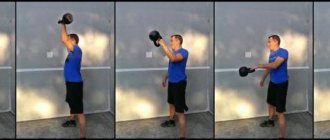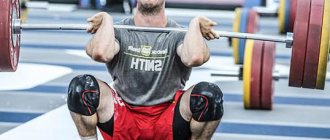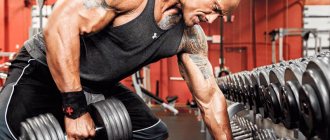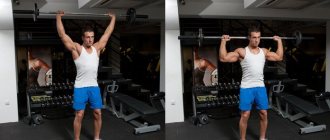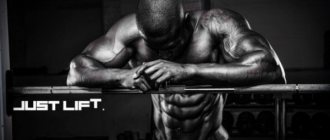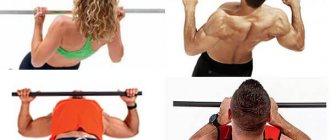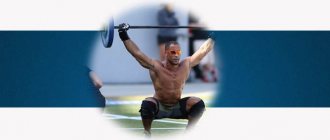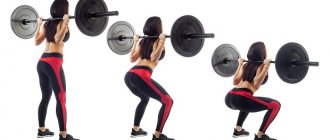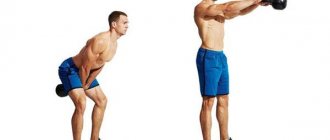Author: Timko Ilya - the ruler of the entire site and fitness trainer | more details >> Rod. 1984 Trained since 1999 Trained since 2007. Author and creator of the site tvoytrener.com. CCM in powerlifting. Champion of Russia and South Russia according to AWPC. Champion of the Krasnodar region according to IPF. 1st category in weightlifting. 2-time winner of the Krasnodar Territory championship in t/a. Author of more than 700 articles on fitness and amateur athletics. Author and co-author of 5 books.
Place in the ranking of authors:
out of competition
(become an author)
Date:
2016-09-11
Views:
10,847
Rating:
5.0
| All articles by the author >> | Medals articles >> |
Articles are loading...
Primary Muscles - Anterior thighs, glutes, back extensors, traps, calves
Secondary Muscles - Latissimus, forearms, hamstrings, inner thighs, biceps
Difficulty : high
Load by muscle group
The load is indicated on a 10-point scale (the total load is summed up)
| Front thigh | 10 (high) |
| Buttocks | 9 (high) |
| Shin | 8 (high) |
| Upper back | 8 (high) |
| Small of the back | 7 (high) |
| Posterior thigh | 5 (average) |
| Forearms | 4 (average) |
| Inner thigh | 4 (average) |
| Latissimus muscles | 3 (average) |
| Biceps | 3 (average) |
| Total load/exercise type | 61 (high) / basic global |
| Load on the spine | 7 (high) |
Execution technique
You need to grab the bar with a standard grip, which is used to perform a snatch, and lift the barbell to its full height. After this, lower the bar to the desired level. Although athletes choose it depending on their physical parameters, the standard is from the mid-thigh.
Next, pushing with your feet from the floor, you must sharply extend your pelvis until your body is completely straightened, and the barbell is at the top with the help of a jerk into the rack. Immediately after, a squat is performed so that the weight of the barbell is distributed throughout the body. To do this, the knees bend a little, and the athlete seems to dive under the bar.
After this, the position is stabilized, and the athlete stands up to his full height with the barbell above his head. It is advisable to linger at the highest point for a few seconds, then lower the load. The rack jerk helps to load the muscles of the back and chest at the same time, while having a positive effect on the muscular corset.
Description of the exercise
This exercise represents the first part of the classic clean and jerk and consists of 4 phases: pulling, lifting, leaving and receiving the barbell on the chest, standing up. For beginners, I advise you to learn the chest clean separately and the chest jerk separately. It's easier to learn this way.
I advise you to do this exercise separately if you can push from the chest more than you can take to the chest. That is, when the chest lift is your weak point. If it’s the other way around, then it’s better to ceiling it separately from the racks.
Nuances and errors
1. Starting pose. At the start, your feet should be hip-width apart and your toes turned to the sides. You need to stand on your entire foot. Shoulders slightly forward of the bar. The grip is slightly wider than the shoulders and in the lock. The bar touches the shin, the knees are slightly turned to the sides following the toes.
2. It is better to start pulling smoothly and without jerking. Remember, the main thing is not how fast you pull, but how fast you undermine. The trajectory of the bar during a deadlift is a straight line, tilted slightly towards itself. This means that as the barbell rises, your center of gravity should shift to your heels.
3. It is very important not to circle the bar around your knees while deadlifting. To do this, the knees are pulled back to the sides. The pulling phase continues until about mid-thigh or slightly higher.
4. At the end of the pull phase, your legs should not be completely straight. A slight angle in the knee joints should be maintained. Otherwise, the legs will be switched off from the explosion. In addition, the weight should already be on your heels by then, and the bar should touch your hips.
5. When the lifting begins, the barbell is first accelerated by the legs and back. Then the lower leg and trapezius pick up the baton. That is, you need to pull your trapezoids towards your ears and step out onto your toes. And the last to be used are the hands. But only at the end of the explosion. With your hands you need to lift the barbell to the highest point of lifting and take it to your chest.
6. Stretching. After pushing off the floor, you need to spread your legs to the sides. On average, the legs are spread from hip width to shoulder width. But this is all purely individual. Some people hardly scatter at all, while others scatter twice as wide.
7. At the moment of detonation, you cannot move your back too far back. Slightly is possible, but not much. Otherwise, this will cause the projectile to fly in a strong arc. That is, the bar will not fly up, but forward.
8. One of the common mistakes (especially with heavy weights) is too short a blast. That is, the athlete does not allow the bar to complete its trajectory and goes under it ahead of time. As a result, the bar does not gain the required height and remains ahead. In addition, with a short lift, the athlete does not have time to fully open up and takes the barbell “crumpled” to his chest. That is, hunched over.
9. It is very important when taking the barbell to the chest to immediately raise your elbows so that the bar rests confidently on your shoulders. Otherwise, with large weights, the bar will simply roll down.
10. It is better to get up from sitting right away. That is, in return. This way you save energy. And with more weight it’s much easier to stand up this way.
11. I advise you to take it on your chest without straps. It is dangerous to use straps when pushing, because if you tighten them too tightly, you can injure your hand.
12. To summarize. Don't rush to undermine. Wait until you reach at least mid-thigh. Don't rush to go under the bar. Wait until the bar reaches its maximum height. Well, at the end of the explosion, actively use your hands.
What muscles does it work?
What muscles work when doing a barbell clean? The lion's share of the load is distributed between the gluteal muscles, quadriceps, deltoids and trapezius. The hamstrings and spinal extensors are slightly less involved. It is worth noting that the abdominal press also significantly influences the execution of the exercise, helping to stabilize the position of the body, so it should be in static tension throughout the entire movement.
The benefit of performing barbell cleans is that it helps develop muscles such as deltoids, trapezius, quadriceps and glutes.
Moreover, due to its multi-joint nature, an experienced athlete is able to lift decent weights in this movement, which has a beneficial effect on the production of one’s own testosterone. Due to the fact that the barbell clean is a basic exercise, an increase in strength indicators in it will lead to an increase in working weights in exercises such as the snatch, front squats, deadlifts, good-mornings, thrusters, etc.
"10 for 27." Oleg Saitov is the best amateur boxer in recent Russian history
15:53 05/20/2020 — Sports policy
The All Sport agency continues the project “10 for 27” - a rating of the best athletes in Russia in Olympic sports over the 27 years since the collapse of the USSR. Today the focus is on amateur boxing. We remind you: the TOP 10 cannot include athletes who received sanctions for violating anti-doping rules (or have official complaints in the present) - even if they retained their titles and records. Therefore, the Olympic, world and European champion Alexander Povetkin is not in the top ten (even though doping scandals happened to him already in professional boxing). The first among the best in amateur boxing “10 for 27” was two-time Olympic champion, world champion and European champion Oleg Saitov (pictured).
"10 for 27." The best athletes of Russia
The best Russians in boxing (since 1993)
1. Oleg Saitov (weight categories up to 67 and 69 kg)
Two-time Olympic champion in 1996 and 2000 in the weight category up to 67 kg. Bronze medalist of the Olympic Games (2004 – up to 69 kg). The only winner in Russian history of the Val Barker Cup for the most technical boxer of the Olympic Games (2000). World champion (1997 – 67 kg). Two-time medalist of the world championships - silver (1995 - up to 67 kg) and bronze (1993 - up to 67 kg). Two-time European champion (1998 – up to 67 kg, 2004 – up to 69 kg). Bronze medalist of the European Championship (1996 – up to 67 kg).
2. Alexey Tishchenko (weight categories up to 57 and 60 kg)
Two-time Olympic champion - 2004 in the weight category up to 57 kg, in 2008 up to 60 kg. World champion (2005 – up to 57 kg). Bronze medalist of the World Championship (2007 – up to 60 kg). European champion (2006 – up to 60 kg).
3. Alexander Lebzyak (weight categories up to 71, 75 and 81 kg)
Olympic champion 2000 in the weight category up to 81 kg. Participant of the 1992 Olympic Games as part of the Unified Team and 1996. World champion (1997 – up to 81 kg). Silver medalist of the World Championship (1991 – up to 75 kg). Two-time European champion (1998, 2000 – up to 81 kg). Three-time medalist of the European Championships - silver (1993 - up to 75 kg) and two-time bronze (1991, 1996 - up to 75 kg). Two-time bronze medalist of the Goodwill Games (1990 - up to 71 kg, 1994 - 75 kg).
4. Gaidarbek Gaidarbekov (weight category up to 75 kg)
Olympic champion 2004. Silver medalist of the Olympic Games (2000). European Champion (2004).
5. Evgeniy Tishchenko (weight category up to 91 kg)
Olympic champion 2020. World Champion (2015). Silver medalist of the World Championship (2013). Two-time European champion (2015, 2017).
6. Egor Mekhontsev (weight categories up to 81 and 91 kg)
Olympic champion 2012 in the weight category up to 81 kg. World champion (2009 – up to 91 kg). Bronze medalist of the World Championship (2011 – up to 81 kg). Two-time European champion (2008, 2010 – up to 91 kg).
7. Rakhim Chakhkiev (weight category up to 91 kg)
Olympic champion 2008. Silver medalist of the World Championship (2007).
8. Raimkul Malakhbekov (weight categories up to 54 and 57 kg)
Two-time Olympic medalist in the up to 54 kg weight category - bronze in 1996 and silver in 2000. Two-time world champion (1995, 1997 – up to 54 kg). Two-time European champion (1993 – up to 54 kg, 2002 – up to 57 kg). Three-time medalist of the European Championships - two-time silver (1998, 2000 - up to 54 kg) and bronze (1998 - up to 54 kg).
9. Sofia Ochigava (weight categories up to 52, 54, 57 and 60 kg)
Silver medalist of the 2012 Olympic Games in the weight category up to 60 kg. Two-time world champion (2005 – up to 52 kg, 2006 – up to 54 kg). Two-time medalist of the world championships - silver (2012 - up to 60 kg) and bronze (2008 - up to 57 kg). Three-time European champion (2005 – up to 52 kg, 2007 – up to 54 kg, 2009 – up to 57 kg). Two-time winner of the European Championships - silver (2011 - up to 60 kg) and bronze (2006 - up to 54 kg).
10. Evgeniy Makarenko (weight category up to 81 kg)
Participant of the 2004 Olympic Games. Two-time world champion (2001, 2003). Two-time European champion (2002, 2004). Bronze medalist of the European Championship (1998).
Kettlebell as an alternative
In terms of usefulness, it is difficult to replace a barbell with other equipment, because exercise machines cannot give such results if the weight is selected correctly and the execution technique is followed. Beginning athletes can perform the dumbbell snatch to work on movements and warm up the muscles.
An alternative to dumbbells can be a kettlebell. It creates stress on one arm and at the same time effectively develops muscles. It is recommended to perform from a hanging position, although you can lift the weight from the floor, this does not affect the effectiveness. The number of repetitions should be from 3 to 5 with several sets depending on the level of endurance.
The kettlebell is used as an intermediate step between dumbbells and a barbell. This is a good load with minimal harm and possible errors. As for the weight of the kettlebell, it is selected depending on the capabilities of the athlete.
Load target
If we talk about beginner athletes, then for them the exercise is an option for applying the technique in practice. By working on the snatch, you can learn to smoothly transfer weight from the lower part to the body and focus the load on the back muscles.
Regular execution also actively affects the development of movement power and increases leg endurance. The speed of movement is worked out, thereby reducing the risk of stretching soft tissues. In the process of building muscle mass, different types of loads are used to help achieve the desired result.
Difference between powerlifting and weightlifting
As mentioned above, weightlifting is a sport consisting of two exercises, namely the clean and jerk and the snatch.
Powerlifting is also a strength sport, but not an Olympic one; in the same way, athletes try to set personal records in maximum weights in exercises over time. However, the exercises in powerlifting are different: barbell squats, bench presses and deadlifts.
However, just like powerlifting, weightlifting athletes will need it to achieve results.
Sign up for a course
You can find out more about this sport in our article on powerlifting.
